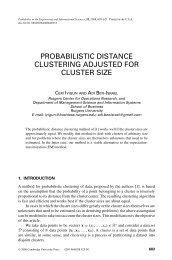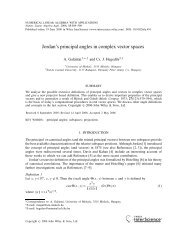Generalized inverse formulas using the Schur ... - Benisrael.net
Generalized inverse formulas using the Schur ... - Benisrael.net
Generalized inverse formulas using the Schur ... - Benisrael.net
You also want an ePaper? Increase the reach of your titles
YUMPU automatically turns print PDFs into web optimized ePapers that Google loves.
Note that (1.6) is equivalent toGENERALIZED INVERSE FORMULAS 255(1.10) C CA(1)A for every A (),that (1.7) is equivalent to(1.11) B AA(I)B for every A (1),and similarly for (1.8) and (1.9). We shall say that M satisfies (N1) if (1.6) and (1.7)hold, (N3) if (1.7) and (1.8) hold, (N4) if (1.6) and (1.9) hold, and (N) if m satisfies(N3) and (N4). The numbering of <strong>the</strong> conditions (N1), (N3), (N,) correspondswith <strong>the</strong> numbering of <strong>the</strong> equations for <strong>the</strong> Moore-Penrose <strong>inverse</strong>. As will beseen (Theorem 1 (ii)) no condition is needed on M for existence of an M (2) in <strong>the</strong>form (2.1) so (N2) is omitted.2. A formula for generalized <strong>inverse</strong>s. Suppose M is in form (1.5), whereA is p q and D is (l p) (n q). Consider a matrix of <strong>the</strong> form(2.1) rnIa + aBsCa-sCaaBsl swhere a is q x p and s is (n- q) (l- p). We shall show that under certainconditions m is a generalized <strong>inverse</strong> of M.Let S D CaB. The following statements are easily verified (see Appendix):If al, a2 are (1)-<strong>inverse</strong>s of A, <strong>the</strong>n CalB CazB if (1.6) and (1.7) hold. Thusunder certain conditions S is independent of <strong>the</strong> choice of a. However, in <strong>the</strong> sequelwe shall always assume that S is given in terms of a specific choice of a.If a, s satisfy (1.1) relative to A, S respectively, <strong>the</strong>n m satisfies (1.1) relative toM if and only if M MmM 0 or"(2.2)(2.3)(I Ss)C(I aA) O,(I Aa)B(I sS) O,(2.4) (I Aa)BsC(I aA) O.Then m satisfies (1.1) relative to M if M satisfies any one of (N1) or (N3) or (N4).If a, s satisfy (1.2) relative to A, S respectively, <strong>the</strong>n m always satisfies (1.2)relative to M.If a, s satisfy (1.3) relative to A, S respectively, <strong>the</strong>n m satisfies (1.3) relative toM if M satisfies (N3).If a A (1’3), s S(1’3), and m M (1’3), <strong>the</strong>n (Mm)* Mm implies(2.5) [(I Ss)Ca]* (I- Aa)Bswhich toge<strong>the</strong>r with (2.3) implies (1.7) holds. Moreover, <strong>the</strong> conjugate transposeof (2.5) in view of (2.2) shows that (1.8) must hold.If a, s satisfy (1.4) relative to A, S respectively, <strong>the</strong>n m satisfies (1.4) relative toM if M satisfiesSimilarly if a A (1’4), s S(1’4), and m M(1’4), <strong>the</strong>n M satisfiesTherefore we have <strong>the</strong> following <strong>the</strong>orem.






